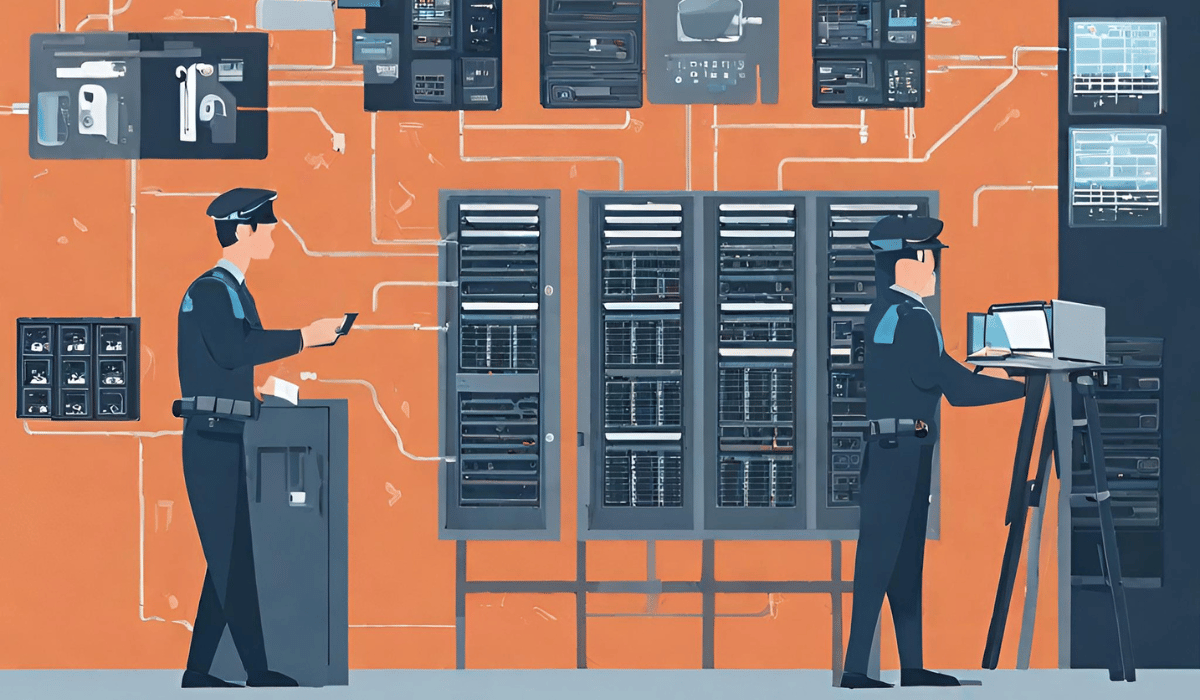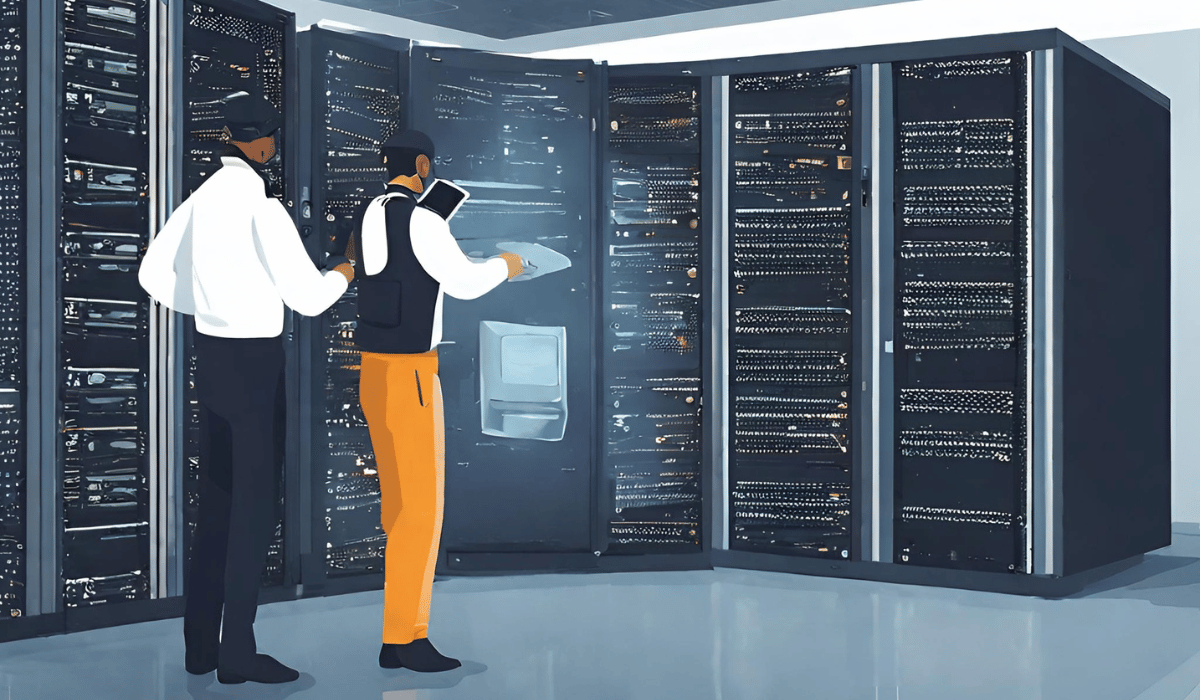Definition of Data Centre Security

Data centre security refers to the measures and protocols put in place to protect the physical and digital assets stored in a data centre. This includes safeguarding against unauthorized access, theft, damage, and other threats that could compromise the integrity and confidentiality of the data. Data centre security typically involves a combination of physical security measures such as access controls, surveillance cameras, and alarms, as well as digital security measures such as firewalls, encryption, and intrusion detection systems.
Threats to Data Center Security
- Cyber attacks
- Physical attacks
- Natural disasters
Components of Data Center Security
- Access controls
- Authentication mechanisms
- Firewalls
- Intrusion detection and prevention systems
- Encryption
- Backup and recovery systems
- Security information and event management (SIEM) systems
Best Practices for Data Center Security
- Regular risk assessments
- Implementation of security policies
- Regular security training for staff
- Compliance with industry standards and regulations
- Regular software and hardware updates
- Regular backups and disaster recovery planning
Physical Security Measures for Data Centers
- CCTV surveillance
- Biometric access controls
- Mantraps
- Security guards
- Environmental controls
Cybersecurity Measures for Data Centers

Here are some best practices for cybersecurity measures in data centres:
1. Network segmentation: Segregate the network into smaller, more manageable sections to limit the spread of malware and other security threats.
2. Access controls: Implement strong authentication and authorization controls to ensure that only authorized personnel can access critical systems and data.
3. Encryption: Use encryption to protect sensitive data both at rest and in transit.
4. Intrusion detection and prevention: Deploy intrusion detection and prevention systems to monitor network traffic and identify
5. Disaster recovery and business continuity planning: Develop and implement a comprehensive disaster recovery and business continuity plan to ensure that critical systems and data can be restored in the event of a disaster or outage.
6. Regular updates and patches: Keep all software and systems up-to-date with the latest security patches and updates to address any known vulnerabilities.
7. Employee training and awareness: Educate employees on best practices for security and raise awareness of potential threats such as phishing scams and social engineering attacks.
Importance of Disaster Recovery Planning

Disaster recovery planning is crucial for businesses of all sizes because it helps ensure that critical systems and data can be restored in the event of a disaster or outage. Without a proper plan in place, businesses risk losing valuable data, experiencing prolonged downtime, and potentially damaging their reputation. In addition, disaster recovery planning can help businesses comply with industry regulations and avoid costly fines.
Best Practices For Disaster Recovery Planning
Here are some best practices for disaster recovery planning:
1. Identify critical systems and data: Identify the systems and data that are critical to your business operations and prioritize them for recovery in the event of a disaster.
2. Develop a recovery strategy: Develop a recovery strategy that outlines the steps to be taken to restore critical systems and data in the event of a disaster. This strategy should include backup and recovery procedures, as well as communication and notification plans.
Challenges and Solutions in Data Center Security
Data centre security is a critical aspect of any business that relies on technology for its operations. However, there are several challenges that organizations face when it comes to securing their data centres.
Complexity Of Modern Data Centres
To restore critical systems and data in the event of a disaster, the following steps should be taken:
1. Develop a disaster recovery plan: This plan should outline the steps to be taken in the event of a disaster, including backup and recovery procedures, communication and notification plans, and any other necessary steps to restore critical systems and data.
2. Regularly backup data: It is essential to backup data regularly, either on-site or off-site.
Insider Threats
To mitigate insider threats in a data centre, the following measures can be taken:
1. Access control: Limit access to critical systems and data to only authorized personnel. Implement strong password policies and multi-factor authentication to ensure that only authorized individuals can access sensitive information.
2. Monitoring: Monitor employee activity within the data centre, including network activity, system access, and data transfers. This can help detect any unusual behaviour that may indicate an insider threat.
Shadow IT
To address the issue of Shadow IT, the following measures can be taken:
1. Educate employees: Train employees on the risks of using unauthorized software or services and the importance of adhering to company policies and procedures.
2. Implement a formal approval process: Establish a formal process for employees to request and obtain approval for new software or services.
3. Monitor network traffic: Monitor network traffic to identify any unauthorized software or services being used within the organization.
Solutions to Common Challenges
Here are some solutions to common challenges that organizations may face when implementing the above measures:
1. Resistance from employees: Some employees may resist the implementation of new policies or procedures. To address this, it is important to communicate the reasons behind the changes and the benefits to the organization and its employees.
2. Lack of resources: Implementing new policies and procedures may require additional resources, such as staff or technology. It is important to allocate the necessary resources to ensure the success of the implementation.
Future of Data Center Security
The future of data centre security will likely involve increased use of artificial intelligence and machine learning to detect and respond to threats in real time. This will enable data centres to better protect against cyber-attacks and other security breaches. Additionally, there may be a shift towards more decentralized data centres, which can provide increased security and resilience against attacks. However, as technology continues to evolve, so will the threats to data centre security, making it important for organizations to remain vigilant and adaptable in their security strategies.
Conclusion
In conclusion, data centre security is a critical aspect of modern business operations. With the increasing amount of sensitive data being stored and processed in data centres, organizations need to prioritize security measures to protect against cyber-attacks and other threats. As technology advances, the threats to data centre security will continue to evolve, making it important for organizations to remain proactive and adaptable in their security strategies.
FAQs
What are the threats to data centre security?
There are various threats to data centre security, including cyber-attacks, physical breaches, insider threats, and natural disasters. Cyber-attacks can come in the form of malware, ransomware, phishing, and denial-of-service (DoS) attacks. Physical breaches can occur when unauthorized individuals gain access to the data centre premises. Insider threats can arise from employees or contractors who have access to sensitive information and intentionally or unintentionally cause harm.
What are the best practices for data centre security?
Several best practices for data centre security can help mitigate the risks of cyber-attacks, physical breaches, insider threats, and natural disasters. Here are some of them:
1. Conduct regular risk assessments: Identify potential threats and vulnerabilities and assess the likelihood and impact of each.
2. Implement access controls: Use multi-factor authentication, access cards, and biometric identification to control physical and logical access to the data centre.
What are the physical security measures for data centres?
Several physical security measures can be implemented in data centres to protect against unauthorized access, theft, and damage. Here are some examples:
1. Perimeter security: Install fencing, walls, and gates around the data centre to restrict access to authorized personnel only.
2. Access controls: Use multi-factor authentication, access cards, and biometric identification to control physical access to the data centre.
3. Video surveillance: Install CCTV cameras to monitor the data centre perimeter and critical areas inside the facility.
What are the cybersecurity measures for data centres?
Several cybersecurity measures can be implemented to protect data centres from cyber threats. Here are some examples:
1. Firewall protection: Install a firewall to prevent unauthorized access to the data centre’s network.
2. Intrusion detection and prevention: Use intrusion detection and prevention systems to monitor network traffic and detect any suspicious activity.
3. Data encryption: Encrypt sensitive data to protect it from unauthorized access in case it is stolen.
What is disaster recovery planning?
Disaster recovery planning is the process of creating a plan to recover data and restore IT systems after a disruptive event, such as a cyber attack, natural disaster, or human error. This plan outlines the steps that need to be taken to minimize the impact of the disaster and restore normal operations as quickly as possible. It includes procedures for data backup and recovery, system failover, and communication with stakeholders.
What are the challenges in data centre security?
There are several challenges in data centre security, including:
1. Physical security: Data centres need to be physically secured from unauthorized access. This includes ensuring that only authorized personnel have access to the facility and that there are measures in place to prevent theft, vandalism, and other physical threats.
2. Cybersecurity: Data centres are prime targets for cyber attacks, as they store large amounts of sensitive data. It is important to have robust cybersecurity measures in place, including firewalls, intrusion detection systems.
What is the future of data centre security?
The future of data centre security is likely to involve a combination of advanced technologies and more stringent regulations. Some of the emerging technologies that may play a role in data centre security include machine learning, artificial intelligence, and blockchain. These technologies can help to detect and prevent cyber attacks, as well as provide greater transparency and accountability in data management. Additionally, governments and regulatory bodies are likely to impose stricter requirements on data center security, to protect the privacy and security of individuals and organizations.
